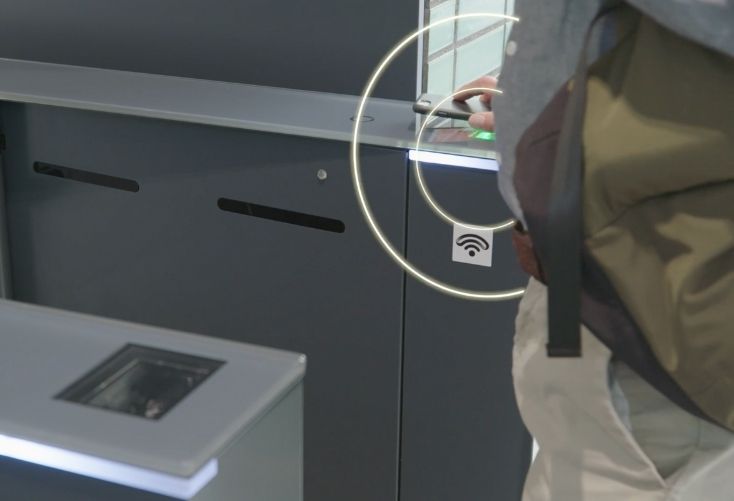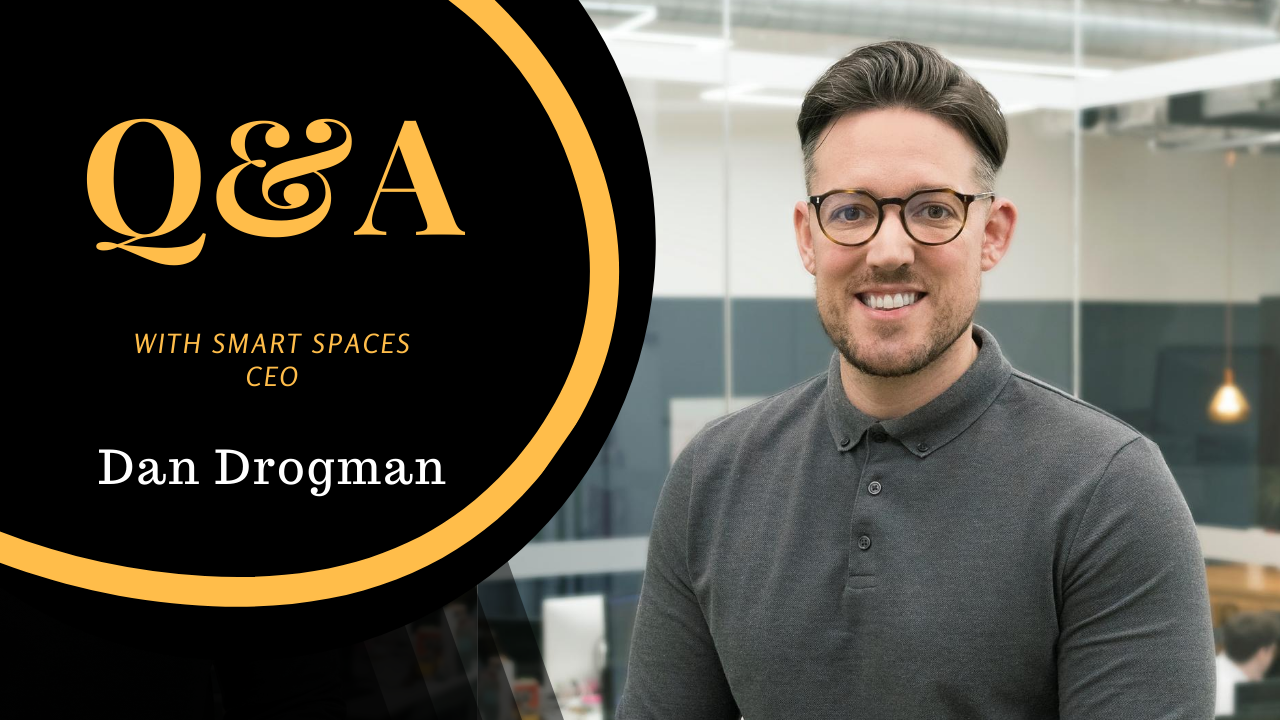- Contactless access and visitor management are now key workspace technologies.
- Long-term, property companies must adapt to the changes on the horizon.
- In this Q&A with Allwork.Space, Smart Spaces CEO Dan Drogman discusses Covid-19 as “the biggest social experiment in living memory” and why now is the time to change our approach to technology.
In the wake of the Covid-19 crisis, how do you create a smart space to protect your members as the world of work gradually returns? There are plenty of options available. With the right technology, you can create healthy buildings, transform your space into a touchless tech haven, or even hire a robot to keep your office clean.
UK-based company Smart Spaces provides workspace operators with another option. Using the Smart Spaces app, operators can control every aspect of their space from their phone. This solution lets you control your environment, lights, community activities, security and provide contactless access for your members — all with the swipe of a smartphone.

The Smart Building OS 360° software platform takes things one step further — with a Digital Twin connecting every operational part of your building using a network of sensors, hardware and BIM modelling to provide real-time data and visualisations of your workspace in action.
Founded in 2010, Smart Spaces now powers over 10 million square-feet of UK real estate, deploying smart building technology such as contactless access, smart visitor management systems and its community engagement app.
We spoke to Dan Drogman, chief executive of Smart Spaces, to find out how Covid-19 has affected business and what the new normal will look like for workspace operators.
Allwork.Space: How has the recent Covid-19 crisis affected your business?
Dan Drogman: The sudden onset and subsequent impacts of Covid-19 has accelerated trends around flexible working, community engagement and space optimisation which are well suited for smart buildings. In the immediate term, our clients and new clients responded by focusing on contactless access and visitor management to aid occupiers with their return to office planning.
Other approaches to de-risk Covid-19 include contactless destination control including lifts, control of climate, control of lighting, desk and meeting room booking and food ordering. These are all via the app to reduce the amount of shared surfaces workers need to touch and importantly, offer longevity as trends accelerate to smart technology in any event.
Allwork.Space: What benefits can such smart technologies bring?
Forward planning has seen real estate companies increasingly placing an emphasis on realising the benefits that smart building technology can bring to their asset in terms of appeal to occupiers, driving operational efficiency and reducing energy consumption. From a business engagement perspective, it can help your employees feel more secure and confident in the workplace, as companies start to ask their employees to return to their places of work as they transition to a hybrid office/WFH model.
The Covid crisis has also highlighted the availability and speed of deployment of smart building technology which is not as costly as expected. We have continued to deliver new smart enabled features throughout lockdown using sensors to help visualise how people move through buildings and stay social distanced.
Allwork.Space: Under physical distancing, what smart technologies do you think will be popular in the world’s shared workspaces?
I’d highlight three main areas, which are included in our smart building software solutions. First, touch free access control. The adoption of smart visitor management systems allows for the integration of hands-free access with workers able to use their smartphone as their access pass to the building, doors and lifts thereby limiting touch points.

Second, 3D printed colour coded flags. In our app, the 3D printed room and desk status flags digitally change their colour to show the room status – occupied, free, ready to be cleaned, cleaning in progress, and more – offering an easy-to-implement, universally understood, tool to keep people informed at any time.
Integration with our meeting room booking system, as well as washrooms, use notifications and cleaning routine management, means occupiers won’t risk entering an occupied room accidentally. The space management sensors connected to our smart app will send a signal to the flags when the room density is at capacity in respect to social distancing rules providing a safer use of the work environment for everyone.
Lastly, the community app. The wellbeing of workers remains hugely important and our community app is a great way of staying in touch with colleagues, benefitting from exclusive offers and maintaining a sense of community. The app is designed to help create an enhanced work-life balance for occupiers and their employees. To build a connected and active community, our platform offers a Social Wall, a scrollable feed in which to share the latest news, events and activities to keep up to date with the workplace life, a personal chat and call feature for private conversation and free access to a list of curated magazines for break time.
Allwork.Space: What barriers to adoption exist for these technologies for operators?
The deployment of smart technology can be straightforward and not as costly as expected. We have continued to install new smart enabled features throughout lockdown, some through remote assessments via a simple questionnaire to determine whether you can unlock hidden features and functionality within existing building systems.
To ensure a high standard of security is always maintained, our platform is protected against cybersecurity attacks and individual access rights are managed by the building administrator at occupiers’ level.
Allwork.Space: How do you think smart technologies can mitigate the concerns workers may have about returning to their shared workspaces? Is there any particular in-demand technology?
Individual responsibility is still paramount, however, a number of these technologies can help offer reassurance to employees who are heading back to the workplace, to enable them to return safely in the knowledge that their employer has implemented policies to help keep them safe and supported.
Touch free access control has been the most in-demand technology. The adoption of smart visitor management systems allows for the integration of hands-free access with workers able to use their smartphone as their access pass to the building, doors and lifts thereby limiting touch points.
We’ve also seen an increase in the number of enquiries relating to air quality assessment and management. Via our digital twin, a 3D replica of the building, we can provide a 360° view, at floor and room level, alongside full remote control over the HVAC system with real-time operating, maintenance and engineering actioning.
We’ve seen a lot of much-hyped workplace technologies fall by the wayside over the years (VR being a prime example) – how can operators future proof their approach to smart technologies? What do they need to look out for?
VR never really took off in the home, which impacted its exposure to the people who run commercial businesses. Hive and Nest and voice control like Alexa and Google Home have captured the retail market and familiarity with these systems is on the increase. Therefore, commercial understanding and adoption of ‘smart’ is in line with consumer expectations i.e. I can change the temperature at home with my app, why can’t I do so at the office?
By focusing on the user-experience and what you want to achieve through the adoption of smart technology, you also need to see tangible business benefits which Smart Spaces can clearly evidence to the market. This all helps to bring confidence and inspiration to real estate which is traditionally behind other markets in this regard.
Allwork.Space: Talking of VR, do you think this has a role/place in our future, shared workplaces?
Ideas and technologies do have a habit of coming back if they are the right product for the right time. Often launched ahead of demand and needing to be sold, these easily fall by the wayside but can re-emerge or achieve sudden mass adoption when the need arises. Zoom for example skyrocketed during the lockdown — no one saw that coming!
Right now, Matterport — a 3D dolls house and walkthrough of buildings that was already in use as a virtual tour, has suddenly become omnipresent in leasing campaigns for obvious reasons. So will VR come back? Quite possibly.
Allwork.Space: Covid aside, what other emerging trends do you think will affect the technologies we see in our shared workspaces in the years ahead?
Activity-based workplaces will be the go-to method to rationalise how much estate any business needs. When we consider working from home, what we really mean is working from anywhere so demand for surplus overflow spaces like coworking and serviced offices on demand will increase.
As large workforces shift to a hybrid office/anywhere working week it is the reduction in density that will have the most impact for traditional offices. For example, booking desks on demand will become increasingly the way businesses manage their shared workspace. This inevitably will lead to a reduction in sq ft required by a lot of companies, however, this may be balanced by the requirement to social distance (particularly in the short term), and other uses i.e. showrooming, breakout and collaborative zones replacing banks of workstations.
This has been and continues to be the biggest social experiment in living memory and for anyone wanting or needing to implement change, then now is the time.

 Dr. Gleb Tsipursky – The Office Whisperer
Dr. Gleb Tsipursky – The Office Whisperer Nirit Cohen – WorkFutures
Nirit Cohen – WorkFutures Angela Howard – Culture Expert
Angela Howard – Culture Expert Drew Jones – Design & Innovation
Drew Jones – Design & Innovation Jonathan Price – CRE & Flex Expert
Jonathan Price – CRE & Flex Expert














